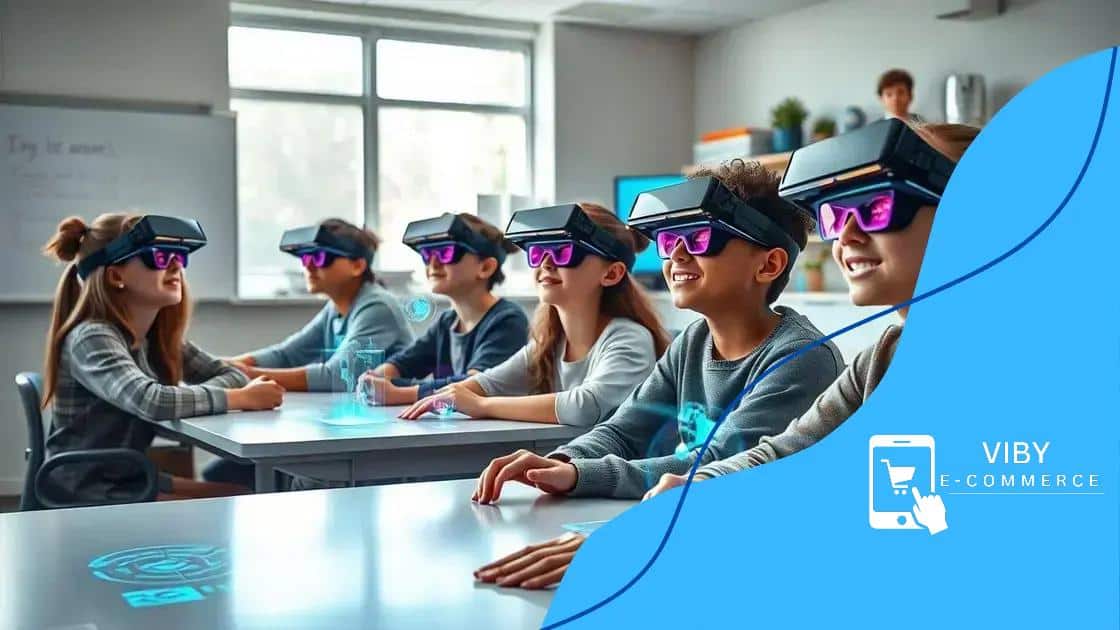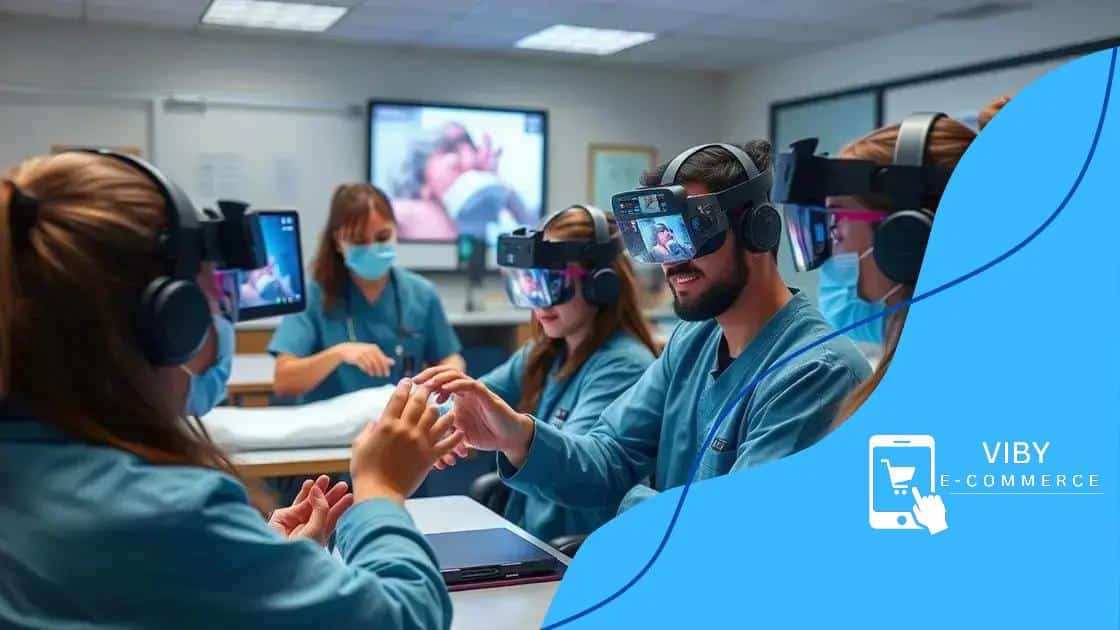How AR is being used for hands-on learning experiences

Augmented reality (AR) is revolutionizing education by offering interactive and immersive learning experiences that enhance student engagement across various subjects.
How AR is being used for hands-on learning experiences is changing the way teachers and students engage with educational material. Imagine stepping into a world where lessons come alive through immersive technology. Intrigued? Let’s dive deeper into how augmented reality is reshaping education.
Understanding augmented reality in education
Understanding augmented reality in education is crucial as it opens up new ways for students to learn. This technology combines the real world with digital elements, making lessons more engaging.
Teachers can use AR to create interactive experiences that deepen understanding. For example, students can explore a virtual solar system, enhancing their grasp of astronomy while remaining in the classroom.
The Basics of Augmented Reality
Augmented reality overlays digital content onto the real world. This technology can be experienced through smartphones, tablets, or special glasses. With AR, students do not just read about a subject; they see and interact with it. This immersive learning style enhances retention and comprehension.
How AR Helps in Learning
- Interactive Learning: Traditional textbooks have limitations, but AR can present information in a fun and captivating way.
- Personalized Experiences: Students can learn at their own pace, exploring topics that interest them in a more interactive setting.
- Collaboration: AR encourages teamwork, as students can work together on projects and explore digital landscapes as a group.
For instance, during a history class, students can use AR apps to visualize historical events or artifacts. This allows them to delve deeper into the past by interacting with three-dimensional models of ancient structures. Such experiences make learning memorable.
Furthermore, many educational institutions are beginning to utilize augmented reality to enhance their curricula. They integrate AR tools into various subjects, making education more dynamic and effective. As technology advances, the possibilities are endless, continually reshaping how knowledge is conveyed.
Overall, understanding how augmented reality influences education reveals its transformative potential. It’s not just about technology; it’s about engaging learners and creating exciting opportunities for discovery.
Engagement through interactive AR applications
Engagement through interactive AR applications has become a key factor in enhancing the learning experience. These applications captivate students by allowing them to participate actively in their education. Instead of passively receiving information, students engage with content in dynamic ways.
For instance, in a science class, students can use an AR app to visualize complex processes, like photosynthesis. This reality brings abstract concepts to life, making them easier to grasp.
Benefits of Interactive AR Applications
Using interactive AR not only boosts student engagement but also fosters collaboration. When students work together on AR projects, they learn from one another and develop valuable teamwork skills. In these settings, students can:
- Experiment: Try out different scenarios in a virtual environment without real-world risks.
- Explore: Discover new subjects and ideas through interactive simulations.
- Enhance Creativity: Build unique projects that combine creativity with technology.
This engagement is evident in classrooms where AR applications are implemented. Students actively explore virtual worlds that enhance their learning experience. As they interact with educational materials in a fun way, they retain information better.
Moreover, teachers benefit from using interactive AR applications. They can tailor lessons to meet diverse learning styles, making education more inclusive. Educators find that students who may struggle in traditional settings thrive when using AR technology. This creates a more equitable learning environment.
In summary, the use of interactive AR applications has revolutionized how educators engage students. It’s not just about teaching; it’s about creating meaningful experiences that foster a deeper understanding of the material.
Enhancing skills with AR simulations

Enhancing skills with AR simulations is transforming how students acquire practical knowledge. These simulations allow learners to practice real-world skills in a safe, virtual environment. For instance, students in nursing programs can use AR to simulate patient care, providing a hands-on experience that enhances their education.
With AR simulations, learners can engage in a variety of scenarios that mimic real tasks. This includes everything from repairing machinery to conducting scientific experiments. By interacting with digital elements, students gain confidence and proficiency before facing actual situations.
Key Benefits of AR Simulations
Using augmented reality for skill development offers several advantages. These simulations help learners:
- Develop Technical Skills: Students can practice skills in mechanics, programming, and engineering through immersive experiences.
- Enhance Problem-Solving Abilities: AR scenarios often involve challenges that require critical thinking and creativity to resolve.
- Receive Immediate Feedback: As students engage with simulations, they get instant insights into their performance, allowing for quick adjustments.
Moreover, teachers find that AR simulations keep students motivated. The interactive nature of these tools captivates students’ attention, making them more likely to pursue challenges and learn effectively. For example, in a chemistry class, students can mix virtual chemicals and observe reactions without any risk.
Additionally, implementing AR in skill training can help bridge the gap for students who struggle in traditional educational formats. This technology caters to various learning styles by making lessons more accessible and engaging. As a result, students can tailor their learning experiences to fit their needs.
Ultimately, utilizing AR simulations in education equips students with the skills they need for the future. By blending technology with practical application, educators can create powerful learning opportunities that prepare students for success in their careers.
Real-world examples of AR in learning
Real-world examples of AR in learning showcase how this technology enhances education across various subjects. Many schools and institutions are adopting augmented reality to create unique learning experiences that engage students better.
For instance, in history classes, students can explore ancient civilizations through AR applications that overlay digital models of historical sites. This immersive experience helps learners visualize and understand the past in a way that traditional textbooks cannot.
Science and Technology
In science education, AR is used to illustrate complex concepts. Students studying biology can use AR apps to interact with 3D models of the human body. They can see organs and systems in real-time, enhancing their understanding of anatomy. By manipulating these digital models, students gain a deeper appreciation for how the body functions.
Mathematics Learning
AR technology also transforms math education by providing interactive problem-solving opportunities. Students can visualize mathematical concepts such as geometry by manipulating shapes in a virtual space. This hands-on approach makes learning math more accessible and enjoyable.
- Real-World Applications: Students can apply their knowledge in virtual scenarios, like engineering and coding projects.
- Motivation: Reshaping traditional lessons into engaging AR experiences boosts students’ interest in learning.
- Collaboration: Group activities incorporating AR promote teamwork among students.
Additionally, universities are utilizing AR in learning to prepare students for real-world challenges. Medical schools, for instance, allow students to perform surgical simulations in a risk-free environment. This practical training ensures that future doctors are well-prepared for their careers.
Another example is in environmental science, where AR applications can simulate ecosystems. Students can observe the effects of climate change on different species and landscapes, leading to a better understanding of ecological balance.
These real-world applications of augmented reality demonstrate its effectiveness in creating dynamic learning environments. As more institutions embrace this technology, the potential for enriching the educational experience continues to grow.
Future trends in AR educational technology
Future trends in AR educational technology promise exciting developments that will shape the way students learn. As technology continues to evolve, educators are constantly seeking innovative tools to enhance classroom experiences.
One major trend is the integration of AR with artificial intelligence. This will enable personalized learning experiences tailored to each student’s needs. For example, AI can analyze a learner’s progress and adapt AR content accordingly, ensuring they grasp difficult concepts.
Increased Accessibility
Another significant trend is the push for greater accessibility. Developers are focusing on creating AR applications that can be used on smartphones and tablets. This means that more students will have access to these engaging learning tools, regardless of their location or resources.
Collaborative Learning
Collaboration will also play a vital role in the future of AR education. Students will be able to work together in virtual environments, no matter where they are. This can lead to shared projects and problem-solving scenarios that enhance teamwork skills.
- Social Interaction: AR will enable students to interact with peers and educators in real-time, fostering a sense of community.
- Global Learning: Access to AR experiences from different countries will allow students to learn about global cultures and topics effortlessly.
- Hands-On Training: Field professionals may use AR for continuous education, ensuring they keep up with industry standards.
The role of gamification in AR educational tools is also on the rise. Developing interactive games that use AR can motivate students to engage with the material in new ways. These game-like elements make learning fun while reinforcing key concepts.
Moreover, advancements in hardware, such as more affordable AR headsets, will enhance the user experience. As these devices become more common in classrooms, students will enjoy increased engagement through immersive learning experiences.
In summary, the future of AR educational technology is bright, with trends pointing toward personalized, accessible, and collaborative learning. As we continue to embrace these innovations, the possibilities for enhancing education are endless.
FAQ – Frequently Asked Questions about Augmented Reality in Education
How does augmented reality enhance student engagement?
Augmented reality enhances student engagement by providing interactive, immersive experiences that make learning more exciting and enjoyable.
What subjects can benefit from AR technology?
AR technology can benefit a wide range of subjects, including science, math, history, and art, by providing dynamic ways to visualize and interact with content.
Are AR applications easy to access for students?
Yes, many AR applications are designed to be accessed on smartphones and tablets, making them widely available to students.
How can AR support collaborative learning?
AR allows students to work together in virtual environments, sharing experiences and learning collaboratively, regardless of their physical location.





